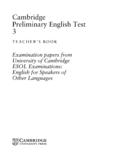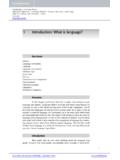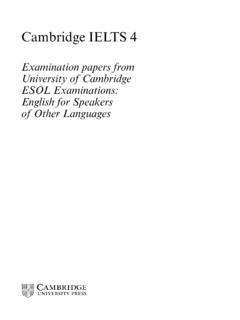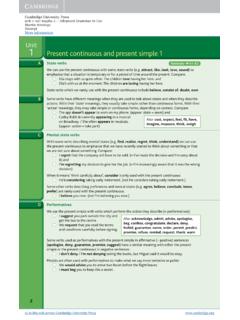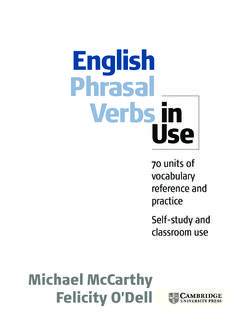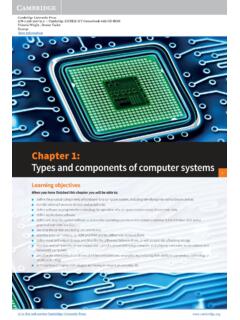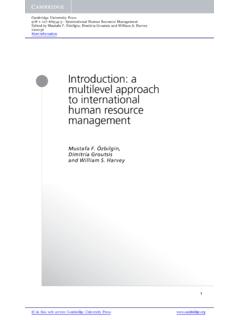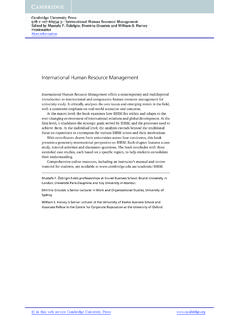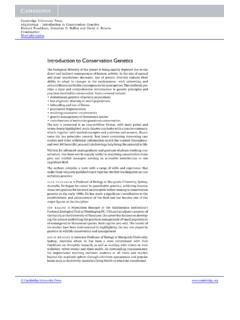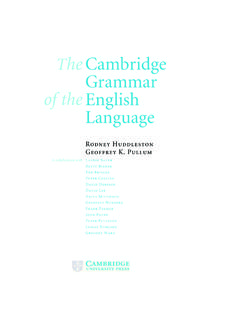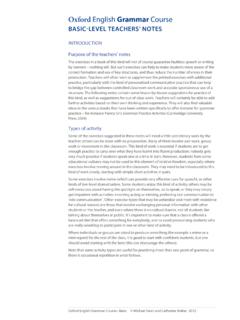Transcription of Syntax, lexical categories, and morphology - Assets
1 Cambridge University Press 0521631998 - An Introduction to Syntax Robert D. Van Valin Excerpt More information Syntax, lexical categories, and morphology CHAPTER 1. Syntax, lexical categories, and morphology Introduction This book is an introduction to the basic concepts of syntax and syntactic analysis. Syntax is a central component of human language . language has often been characterized as a systematic correlation between certain types of gestures and mean- ing, as represented simplistically in Figure For spoken language , the gestures are oral, and for signed language , they are manual. Figure language as a correlation between gestures and meaning It is not the case that every possible meaning that can be expressed is correlated with a unique, unanalyzable gesture, be it oral or manual. Rather, each language has a stock of meaning-bearing elements and different ways of combining them to express different meanings, and these ways of combining them are themselves meaningful.
2 The two English sentences Chris gave the notebook to Dana and Dana gave the notebook to Chris contain exactly the same meaning-bearing elements, words, but they have different meanings because the words are combined differently in them. These differ- ent combinations fall into the realm of syntax; the two sentences differ not in terms of the words in them but rather in terms of their syntax. Syntax can thus be given the following characterization, taken from Matthews (1982:1): The term syntax' is from the Ancient Greek s)ntaxis, a verbal noun which literally means arrangement' or setting out together'. Traditionally, it refers to the branch of grammar dealing with the ways in which words, with or without appropriate inflections, are arranged to show connections of meaning within the sentence. First and foremost, syntax deals with how sentences are constructed, and users of human languages employ a striking variety of possible arrangements of the elements in sentences.
3 One of the most obvious yet important ways in which languages differ is the order of the main elements in a sentence. In English, for example, the subject comes before the verb and the direct object follows the verb. In Lakhota (a Siouan language of North America), on the other hand, the subject and direct object both precede the 1. Cambridge University Press Cambridge University Press 0521631998 - An Introduction to Syntax Robert D. Van Valin Excerpt More information An introduction to syntax verb, while in Toba Batak (an Austronesian language of Indonesia; Schachter 1984b), they both follow the verb. This is illustrated in ( ), in which the teacher, waXspekhiye ki and guru i function as subjects, and a book, w wapi wN and buku function as direct objects. ( ) a. The teacher is reading a book. English b. WaXspekhiye ki w wapi wN yaw . Lakhota teacher the book a read c. Manjaha buku guru i. Toba Batak read book teacher the The Lakhota and Toba Batak sentences also mean the teacher is reading the book', and in the Lakhota example the subject comes first followed by the direct object, whereas in the Toba Batak example the subject comes last in the sentence, with the direct object following the verb and preceding the subject.
4 The basic word order in Toba Batak is thus the opposite of that in Lakhota. There are also languages in which the order of words is normally irrelevant to the interpretation of which element is subject and which is object. This is the case in the following Russian sentences. ( ) a. UAitel'nica Aitaet knigu. Russian teacher read book b. Knigu Aitaet uAitel'nica. book read teacher c. Bitaet uAitel'nica knigu. read teacher book Again, all three of these sentences mean the teacher is reading the book', and in these Russian examples the order of the words is not the key to their interpretation, as it is in the sentences from the other three languages. Rather, it is the form of the words that is crucial. The -a on the end of uAitel'nica teacher' signals that it is the subject, and the -u on the end of knigu book' indicates that it is the direct object. If the word for teacher' were the direct object in a sentence, then it would end in -u, as in ( ).
5 ( ) a. FenCAina videla uAitel'nicu. Russian woman saw teacher b. UAitel'nicu videla EenCAina. teacher saw woman The woman saw the teacher.'. These changes in the form of the words to indicate their function in the sentence are what Matthews referred to as inflections', and the study of the formation of words and how they may change their form is called morphology . These examples illustrate the important relationship between syntax and morphology : something which may be expressed syntactically in some languages may be expressed morphologically in others. Which element is subject and which is object is signalled syntactically in the examples from English, Lakhota and Toba Batak, while it is expressed morphologic- ally in the Russian examples. Syntax and morphology make up what is traditionally referred to as grammar'; an alternative term for it is morphosyntax, which explicitly recognizes the important relationship between syntax and morphology .
6 Even though 2. Cambridge University Press Cambridge University Press 0521631998 - An Introduction to Syntax Robert D. Van Valin Excerpt More information Syntax, lexical categories, and morphology this book is focussed on syntax, morphology will nevertheless be an important part of the discussion. Thus a more complex picture of the nature of language emerges than that given in Figure ; it is summarized in Figure Figure language as a correlation between gestures and meaning (revised). All of the examples looked at so far involve simple sentences, but one of the most important syntactic properties of language is that simple sentences can be combined in various ways to form complex sentences. In terms of Figure , one could say that syntax makes possible the formulation of expressions with complex meanings out of elements with simple meanings. One of the defining features of human language is its unlimited nature; that is, the number of meaningful expressions that can be produced by users of a human language is potentially infinite, and this expressive potential comes from the combination of the basic meaningful elements with syntactic principles.
7 Much of the interest in language in psychology and cognitive science comes from what the study of the cognitive mechanisms underlying language use and acquisition can reveal about the human mind. This book has three goals: first, to introduce the basic concepts of syntax; second, to elucidate the principles and tools of syntactic analysis, which make it possible for linguists to analyze the grammatical systems of human languages; and third, to give an overview of the typological range of phenomena found in human languages which syn- tacticians seek to describe. The content of this book is presupposed by more advanced courses in syntactic theory, and hence it is intended to prepare the reader for such courses. The perspective of the book is primarily descriptive, and theoretical issues will be raised only in chapter 6. To many people the term grammar' evokes bad memories of prescriptive rules learned in school, don't split infinitives!' Since the early part of the twentieth century, linguistics has rejected the prescriptive tradition which underlies school grammars and focusses instead on describing what users of human language actually do, not on prescribing what they should do.
8 A central part of the description of what speakers do is characterizing the gram- matical (or well-formed) sentences of a language and distinguishing them from ungrammatical or (ill-formed) sentences. Grammatical sentences are those that are in accord with the rules and principles of the syntax of a particular language , while un- grammatical sentences violate one or more syntactic rules or principles. For example, ( ) is a grammatical sentence of English, while Teacher the book a reading is would not be. Ungrammatical sentences are marked with an asterisk, hence *Teacher the book a reading is. This sentence is ungrammatical because it violates some of the word order rules for English, that is (i) basic word order in English clauses is subject verb object, (ii) articles like the and a precede the noun they modify, and (iii) auxiliary verbs like is precede the main verb, in this case reading. It is important to note that these are English-specific syntactic rules; this word order is perfectly grammatical in Lakhota, 3.
9 Cambridge University Press Cambridge University Press 0521631998 - An Introduction to Syntax Robert D. Van Valin Excerpt More information An introduction to syntax as ( ) shows, and if the Lakhota words were arranged in the English order, *Ki waXspekhiye yaw wN w wapi [the teacher reads a book], the result is thoroughly ungrammatical. Well-formed sentences are those that are in accord with the syntactic rules of the language ; this does not entail that they always make sense semantically. For example, the sentence the book is reading the teacher is nonsensical in terms of its meaning, but it violates no syntactic rules or principles of English; indeed, it has exactly the same syntactic structure as ( ). Hence it is grammatical (well-formed), despite being semantically odd. The organization of the book is as follows. In this chapter a number of distinctions that are relevant to the discussion in the remainder of the book are introduced. First, two aspects of syntactic structure are distinguished, one of which will be the main topic of chapters 2 and 3, and the other will be the main topic of chapter 4.
10 Second, the traditional notion of parts of speech are reviewed, as these categories will be important throughout the book. Finally, a brief introduction to some of the basic concepts of morphology and morphological analysis is presented, with emphasis on those notions that will be especially pertinent to the discussion in the succeeding chapters. The next three chapters present basic syntactic phenomena from two different ana- lytic perspectives and introduce the concepts and analytic tools used in each. Many of the same grammatical phenomena will be analyzed from each perspective. In chapter 5. the basics of writing a grammar to describe syntactic phenomena will be presented; the formulation of rules to express the generalizations arising from syntactic analysis and the role of the lexicon in a grammar will be discussed. Different linguistic theories make different sets of assumptions about the nature of syntactic structure and accord- ingly employ different analytic principles and tools.
